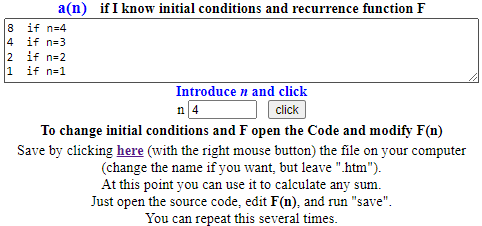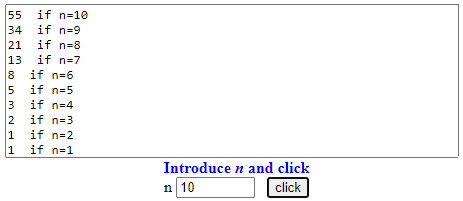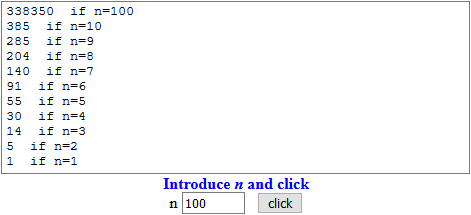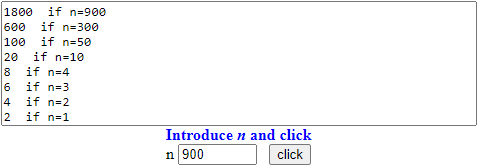
It can be used also the "pocket calculator": see down.
• recursion - A F(1) = 1, F(n+1) = 2·F(n)
function F(n) {
with(Math) {
a = 1; for(i=2; i<=n; i++) {a = 2*a}
return a
}}

• recursion - B
F(1) = 1, F(n+1) =
function F(n) {
with(Math) {
a = 1; for(i=2; i<=n; i++) { a = (a+2/a)/2 }
return a
}}

• recursion - B1
F(1) = 1, F(n+1) =
function F(n) {
with(Math) {
a = 1; for(i=2; i<=n; i++) { a = (a+16/a)/2 }
return a
}}
• recursion - C
F(1)=1, F(2)=1, F(n+2) =
function F(n) {
with(Math) {
a = 1; b = 1; for(i=3; i<=n; i++) {A = a; a = a+b; b = A }
return a
}}

• recursion - D How to study 1² + 2² + 3² + ... + n² ?.
function F(n) {
with(Math) {
a = 1; for(i=2; i<=n; i++) {a = a + pow(i,2) }
return a
}}

It can be shown that 1² + 2² + 3² + ... + n² = n·(n+1)·(2n+1)/6.
• recursion - E
How to study F(n) =
function F(n) {
with(Math) {
m=2*n
a = 0; for(i=1; i<=m; i++) {a = a+pow(-1,i)*(2*i+1)}
return a
}}

F(n) = 2·n.
• See also "square root" and "cube root".
• It can be use also the pocket calculator:
es. B1. I put K in A, F(1) in B, (B + A/B)/2 in the box and click [=], [=], [=], ...

(1+16/1)/2 = 8.5 (8.5+16/8.5)/2 = 5.1911764705882355 (5.1911764705882355+16/5.1911764705882355)/2 = 4.136664722546242 (4.136664722546242+16/4.136664722546242)/2 = 4.002257524798522 (4.002257524798522+16/4.002257524798522)/2 = 4.000000636692939 (4.000000636692939+16/4.000000636692939)/2 = 4.000000000000051 (4.000000000000051+16/4.000000000000051)/2 = 4es. C. I put 1 in A and B and click [=] (1+1=2), I put 1 in A and click [=] (1+2=3), I put 2 in A and click [=] (2+3=5), I put 3 in A and click[=] (3+5=8), I put 5 in A and click [=] (5+8=13), ...
1+1 = 2 1+2 = 3 2+3 = 5 3+5 = 8 5+8 = 13 ...